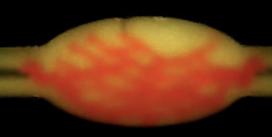ERC Team Uses Novel 3D Bioprinting Method to Create Functional Cardiac Tissue
The NSF-funded Nanosystems Engineering Research Center (ERC) for Cellular Metamaterials (CELL-MET), led by Boston University, developed a 3D bioprinting method that recreates the complex network of blood vessels in the human heart. The technique maintains the viability of bioengineered cardiac tissue after implantation.
One of the current limitations of tissue engineering is its inability to provide sufficient blood supply after implantation. The 3D bioprinting method developed by the ERC team is a huge step toward creating functioning human organs outside the body.
The process developed by the CELL-MET team, called sacrificial writing into functional tissue (SWIFT), prints vascular channel networks directly into living cardiac tissue. This enables the creation of larger tissues approximating the size and function of organs, including heart tissue that beats on its own over a seven-day period. SWIFT only prints the vessels necessary to support living tissue. This technique may ultimately be used therapeutically to repair and replace human organs with lab-grown versions containing a patient’s own cells.
Artificially grown human organs are seen as a possible solution for thousands of people on organ transplant wait lists. To date, 3D-printed human tissue lacks the cellular density and functions required for use in organ repair and replacement. The novel SWIFT method shows promise for resolving these challenges.


